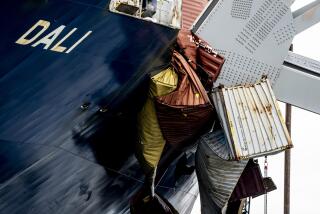Roebling Bridge, Oldest Suspension Span in U.S., Stands as Engineering Treasure
- Share via
LACKAWAXEN, Pa. — Just downstream from where Zane Grey penned his first Western novel, an American engineering treasure hangs over the wind-swept Delaware River in quiet obscurity.
Its proper name is the Delaware Aqueduct, but most folks living within the steep confines of the river valley between Pennsylvania and New York know it as the Roebling Bridge.
Built by John A. Roebling to carry the Delaware & Hudson Canal over the Delaware, the 138-year-old aqueduct bridge is an icon of an era when coal moved the country and canal boats moved the coal.
Today, the structure is recognized as America’s oldest existing suspension bridge. It also represents the earliest surviving example of the innovations Roebling would later put into his most famous creation, the Brooklyn Bridge.
“Of all the civil engineering relics in this country, the Delaware Aqueduct is probably at the top of the list,” said Robert Vogel, curator of civil engineering in the Smithsonian Institution’s Museum of American History in Washington. “I can’t imagine anything more significant.”
Renovation Plan
Suspended by two 8-inch-thick cables each containing 2,150 individual wires, the aqueduct was an anachronism even before Grey gave up dentistry and settled into his white house near the confluence of the Delaware and Lackawaxen rivers in 1905 to pursue a writing career.
The National Park Service is giving the aqueduct a multimillion-dollar face lift that will restore its historical design while allowing a more modern usage--vehicular and pedestrian traffic.
“It’s like pulling the leaves off an artichoke,” Sandra Speers, project manager for the Park Service, said of the reconstruction. “There are so many subtleties, things you don’t see until you take it down and look at it.”
The 535-foot span is due to reopen Saturday, June 13--one day after the 181st anniversary of Roebling’s birth.
Until the 1840s, the Delaware & Hudson Canal Co. had a virtual monopoly on the shipment of anthracite coal from northeastern Pennsylvania to the markets of New York, floating the cargo over its 108-mile network of canals from Honesdale to Rondout, N.Y., and then down the Hudson River.
The worst bottleneck in the system had always been the time-consuming river crossing at Lackawaxen, where canal boats had to be pulled across the Delaware by hand along a ferry rope.
Railroads Spelled Doom
In 1847, Roebling was hired to build a three-pier suspension aqueduct over the river. Acting as both engineer and contractor, he completed the project in time for the 1849 season.
At the peak of Delaware & Hudson’s operations in the 1870s, more than 2 million tons of coal moved through the aqueduct each year. But the railways soon made the canal obsolete, and in 1898, it was abandoned.
Three other Roebling aqueducts on the canal were demolished. The Delaware Aqueduct was drained and converted into a highway toll bridge.
A simple deck system replaced the original wooden trunk by 1930, and the span continued to serve as a toll bridge until 1979. A year later, the Park Service bought the landmark.
One of Roebling’s major innovations was joining the various strands of cable wire into an almost solid cylindrical bundle that was varnished, encased tightly in a continuous wire wrapping and painted.
Despite minor breakage at the piers, the wire in the Delaware Aqueduct is still in superlative condition.
More to Read
Sign up for Essential California
The most important California stories and recommendations in your inbox every morning.
You may occasionally receive promotional content from the Los Angeles Times.













